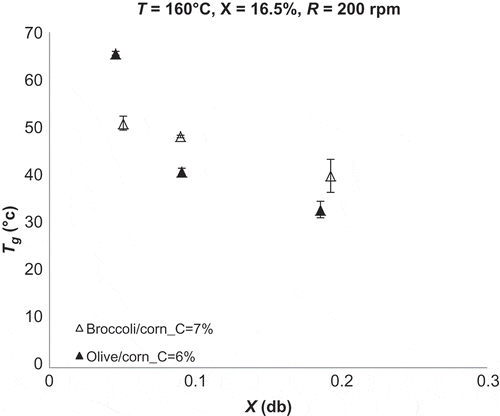Abstract
The growing consumers’ demand for healthier snacks is of high importance and is driving research and industry towards developing novel ready to-eat expanded products. Thus, it would be interesting to enrich these products with additives that possibly lead to highly nutrient products. In the present study, extruded snacks based on corn flour enriched with broccoli or olive paste were developed and studied. Although the addition of broccoli or olive paste in extruded snacks can improve their nutritional properties, the final properties of these products must also be considered. Textural analysis (compression tests), thermal analysis (glass transition temperature), and moisture sorption measurements (sorption isotherms) were performed. A Guggenheim–Anderson–de Boer model has been applied to describe moisture sorption isotherms. Moreover, simple mathematical models were developed in order to correlate textural properties (maximum stress, maximum strain, elasticity parameter, number of cracks) with the process conditions during the extrusion (screw speed, temperature) and the raw materials’ characteristics (moisture content, concentration of broccoli or olive paste). Regression analysis was used to estimate mathematical models’ parameters. The influence of process conditions and raw materials’ characteristics on the measured properties of corn-based snacks enriched with broccoli or olive paste was presented based on the alterations of the estimated parameters.
INTRODUCTION
Extruded snacks consist mainly of starch, which is responsible for most of their structural behavior. The raw ingredients most commonly used in extrusion cooking are rice, wheat, corn, and/or legume flour that lead to different physico-chemical characteristics in the final products and are related to the variations in the chemical composition of the grain.[Citation1–Citation4] Corn starch is the most commonly used ingredient for the production of puffed food snacks through extrusion, which present low protein and other nutrients and are, however, far from satisfying the needs of health-conscious consumers.[Citation2,Citation5–Citation7]
Several attempts to improve the nutritional profile of corn-based extruded snacks using oat flour, milk proteins, legume flours, etc. have been reported.[Citation6–Citation10] The addition of vegetables, fruits, and their by-products to extruded snacks, in order to increase their functionality and nutritional quality, is a growing trend in recent literature. Fruits and vegetables are good sources of beneficial compounds for the human diet, containing many different antioxidant components, which provide protection against harmful free radicals and have been strongly associated with reduced risk of chronic diseases, such as cardiovascular disease, cancer, diabetes, etc., along with other health benefits.[Citation11] The addition of fruit juice, paste, powders, pomace, peels, and seeds, such as lycopene, fresh carrot and carrot leaf, garlic, apple pomace, etc., have been reported in several studies.[Citation1,Citation12–Citation16] Although the addition of several ingredients increases the functionality of the snacks, the acceptability of the snacks depends not only on the high-nutritional characteristics, but also on the acceptable physico-chemical, textural, and thermal properties. These properties are significantly affected by the material characteristics and the processing conditions during extrusion cooking.[Citation2,Citation8]
Broccoli is becoming increasingly popular as a fresh vegetable and is a significant source of nutritional antioxidants, such as vitamins and carotenoids, as well as biologically active dietary components, such as flavonol glycosides, hydroxycinnamic acids, and sulphur-containing compounds.[Citation11,Citation17,Citation18] Olive products, such as olive paste, are widely known for the variety of triterpenes they contain, including oleanolic acid, maslinic acid, uvaol, and erythrodiol. Thus, antioxidant, anti-inflammatory, and antitumoral action have been identified in olive products.[Citation19,Citation20]
Raw materials, such as vegetables, fruits, etc., must be dehydrated prior to extrusion, in order to be added in the extrusion mixture as powders.[Citation21,Citation22] Among the different drying methods, freeze-drying is considered one of the most advanced methods for drying high-value products sensitive to heat, since it produces materials with unchanged nutrition quality, superior taste, aroma, and flavors.[Citation23–Citation25]
The textural properties of foods are related with their sensorial characteristics, and consequently with the quality and acceptance of the product by the consumers. The most common method in determining the texture of foods and especially of extruded products is compression.[Citation26–Citation28] In addition, the knowledge of sorption characteristics and glass transition temperature in different water contents is useful to specify the storage stability of food products.[Citation29] The aim of this study was to develop extruded snacks based on corn flour enriched with broccoli or olive paste. Textural analysis (compression tests), thermal analysis (glass transition temperature), and moisture sorption measurements (sorption isotherms) were performed. Simple mathematical models were developed in order to correlate structural properties (maximum stress, maximum strain, elasticity parameter, number of cracks during compression tests) with the process conditions during the extrusion (screw speed, temperature), as well as the raw materials’ characteristics (moisture content, concentration of broccoli or olive paste), and regression analysis was used to estimate mathematical models’ parameters. Moreover, a Guggenheim–Anderson–de Boer (GAB) model has been applied to describe moisture sorption isotherms.
MATERIALS AND METHODS
Sample Preparation
Corn flour was provided from Marra Bros. Mills S.A. (Korinthos, Greece), and olive paste from Minerva S.A. (Viotia, Greece), while broccoli was purchased from the local market. Broccoli and olive paste were preliminary dehydrated in a laboratory freeze dryer (Leybold-Heraeus GT 2A, Koln, Germany) for 2 days, and were ground to powder. Corn flour and broccoli powder were mixed in different ratios, ranging from 4 to 10% (broccoli concentration: 4, 7, 10%), while corn flour and olive paste powder were mixed in ratios ranging from 4 to 8% (olive paste concentration: 4, 6, 8%). The mixtures were then equilibrated to three moisture levels: 14, 16.5, and 19%. The moisture content was determined using the oven method at 70°C[Citation30] under vacuum, until constant weight. Extrusion was performed in a co-rotating double screw extruder (Prism Eurolab, model KX-16HC, Staffordshire, U.K.). Extrusion temperature varied from 140 to 180°C and the screw speed ranged from 150 to 250 rpm. Extruded materials were stored in laminated bags until required for analysis. The effect of process conditions and materials characteristics was investigated using a central composite design ().
Table 1 Extrusion conditions and materials composition
Compression Tests
Compression tests were conducted in a universal testing machine (Zwick model Z2.5/TN1S, Germany-Ulm). The uniaxial compression tests were performed at room temperature, using a 100 N load cell. Constant deformation rate of 5 mm/min was used for all the materials. Extrudates were cut in cylinders and their dimensions were measured prior to each experiment using a Vernier caliper. Force and deformation were recorded electronically and the resulting stress–strain compression curves were constructed according to the following equations:
Moisture Sorption
Extruded samples were first stored in a desiccator at room temperature for 3 weeks prior to the beginning of the experiment. The samples were then placed in chambers and equilibrated over saturated salts solutions (LiCl, MgCl2, Mg(NO3)2, NaCl, KNO3) of constant water activities environments, ranging from 0.11 to 0.94 (0.11, 0.33, 0.53, 0.75, 0.94) at room temperature. Equilibrium was reached when three consecutive weight measurements did not differ more than 0.001 g. The required time for equilibrium was about 3 weeks. The moisture content of each sample was determined using the oven method at 70°C under vacuum until constant weight.
Measurement of Glass Transition Temperature
Glass transition temperature was determined in the samples of different moisture contents obtained after the equilibrium in the saturated salts solutions. Glass transition temperature (Tg) was estimated using a differential scanning calorimeter (Perkin Elmer DSC 6, CT, USA) with Pyris operation software. Each sample (5–10 mg) was sealed in aluminum pans and scanned from 0 to 100°C at a rate of 5°C/min. A sealed, empty aluminum pan was used as a reference. The glass transition temperature, Tg, was determined as the temperature midpoint of the heat capacity change.[Citation31]
Mathematical Modeling
Several mathematical models were developed in order to predict the values of maximum stress (σmax), maximum strain (ϵmax), elasticity parameter (E), total number of cracks during compression tests (N), with the process conditions during the extrusion (screw speed, temperature) and the raw materials’ characteristics (moisture content, concentration of broccoli or olive paste). The values of σmax, ϵmax, E, and N were correlated with screw speed, extrusion temperature, feed moisture content, and concentration of broccoli or olive paste through the following equation:
Different models, such as Brunauer–Emmett–Teller (BET) and Guggenheim–Anderson–de Boer (GAB) models, semi-empirical models like Ferro–Fontan, Henderson, and Halsey models, as well as empirical models like Smith and Oswin, have been developed to describe moisture sorption isotherms. The GAB model is considered as the most versatile sorption isotherm available in the literature, as it describes the entire range of water activity (0.1 to 0.99).[Citation32] Moreover, the GAB model contains three constants that have physical meaning.[Citation33] The GAB model, applied to the sorption isotherms of extruded products, is expressed as:
Statistical Analysis
Regression analysis, which is based on the minimization of the sum of square residuals between predicted and experimental values, was used to estimate the models’ parameters, as described by Maroulis et al.[Citation33]
RESULTS AND DISCUSSION
The knowledge of the equilibrium moisture content of extruded snacks is indicative of the storage conditions and stability of the products. The sorption isotherms of corn extrudates enriched with broccoli and olive paste are presented in and , respectively, and showed that equilibrium moisture content increased with the increment of water activity. Both broccoli/corn and olive/corn samples present an increment of water sorption in higher feed moisture content and lower extrusion temperature, while slight differences are presented in the different content concentrations and screw speed values. The parameters Xm, C, and K after the appliance of GAB model and the regression analysis are shown in . For broccoli/corn samples, an increment was presented in the three parameters with the increment of feed moisture content and broccoli concentration, while the increment of screw speed and extrusion temperature caused a decrement in Xm and C and an increment in K. Olive/corn extrudates exhibit similar behavior concerning the GAB parameters. The increment of feed moisture content and olive paste concentration causes an increment in Xm and C and a decrement in K, while the opposite trend occurs with the increment of screw speed and extrusion temperature. The increment of Xm and C values present more sorption available sites for water molecules and, hence, the increment in the heat of sorption at the monolayer.[Citation34] Parameter C is related to the adsorption energies of the monolayer, thus the decrease in this value would suggest water molecules less strongly bound to the active sites of the matrix, while K is indicative of the multilayer heat sorption.[Citation34] The highest values of Xm and C were observed in lower extrusion temperatures and higher screw speeds, as far as process conditions during the extrusion is concerned. These differences in extrudates were primarily due to greater starch fragmentation at high screw speeds, which increased the number of free hydroxyl groups available to interact with water, thus making the samples more hydrophilic. Extrusion temperature also has an important effect on GAB parameters. Low extrusion temperatures tend to hinder starch gelatinization making hydrogen bonding difficult and increasing the amount of hydrophilic groups in samples.[Citation35] Considering raw materials’ characteristics, the highest values of Xm and C were observed with the increment of feed moisture content and broccoli or olive paste concentration. This observation could be associated with the higher gelatinization of starch as feed moisture content increased, which breaks down the intermolecular bonds of starch molecules, allowing the hydrogen bonding sites (the hydroxyl hydrogen and oxygen) to engage more water.[Citation36] Moreover, the increment in GAB parameters, as broccoli or olive paste concentration increased caused by the increment in fibers’ content that are hydrophilic due to the presence of free hydroxyl groups on their chemical structure, which generate polarity and attract naturally polarized water molecules. Moreover, fibers have a porous structure that allows for a free movement of water.[Citation37] In addition, olive paste consists not only from fibers but also from antioxidants
Table 2 GAB model parameters and regression analysis from the sorption isotherms
Figure 1 Sorption isotherms of extruded broccoli/corn snacks (GAB model) in the different: (a) broccoli or olive paste/corn ratio, C (%), (b) feed moisture, X (wb%), (c) screw speed (rpm), and (d) extrusion temperature, T (°C).
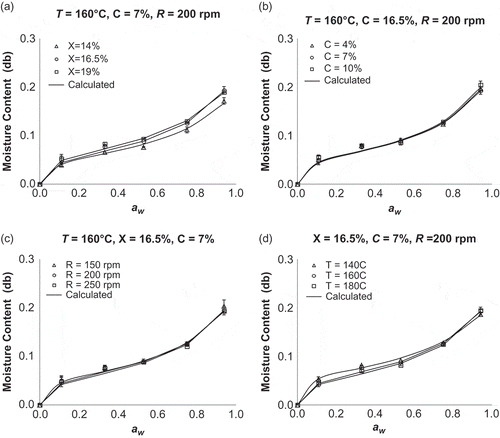
Figure 2 Sorption isotherms of extruded olive/corn snacks (GAB model) in the different: (a) broccoli or olive paste/corn ratio, C (%), (b) feed moisture, X (wb%), (c) screw speed (rpm), and (d) extrusion temperature, T (°C).
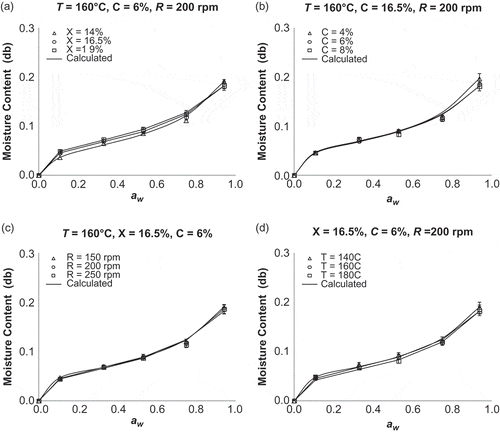
that are either lipophilic or hydrophilic phenols,[Citation38] thus the synergistic action of fibers and hydrophilic phenols dominated and gave a more hydrophilic character in samples as olive paste concentration increased.
Table 3 Glass transition temperatures of extruded broccoli/corn and olive/corn snacks in aw = 0.53
Table 4 Regression analysis of the applied mathematical models for broccoli/corn and olive/corn snacks
Glass transition temperatures of corn extrudates enriched with broccoli and olive paste are shown in as a function of samples’ moisture content after the water sorption in the different constant water activities. Glass transition temperature decreased with the increment of moisture content as it was expected, since water acts as a plasticizer.[Citation39] The knowledge of glass transition temperature is very important because above the Tg, molecular mobility is higher and causes acceleration of the reaction rates while below Tg the food is rigid and stable.[Citation25] As presented in , for both types of extruded corn-based snacks, glass transition temperature increased as broccoli or olive paste concentration and temperature increased due to the rise of starch gelatinization, which occurs in higher extruder temperatures, and the increment in fibers content that lead to denser molecules and as a consequence to higher Tg values.[Citation40,Citation41] A decrement was observed in the highest feed moisture contents, since the increase of water content causes increased segmental mobility of chains in amorphous regions of glassy and partially crystalline polymers.[Citation25] Glass transition temperature values did not reveal a clear trend with the changes of screw speed. Changes in Tg correlated with the alteration on the structure of the extrudates occurred due to the different conditions applied during extrusion and the raw materials’ characteristics. Thus, Tg values are also related to crispness and denseness of extrudates.[Citation42]
Figure 4 Maximum stress for broccoli/corn and olive/corn snacks correlated with: (a) broccoli or olive paste/corn ratio, C (%), (b) feed moisture, X (wb%), (c) screw speed (rpm), and (d) extrusion temperature, T (°C).
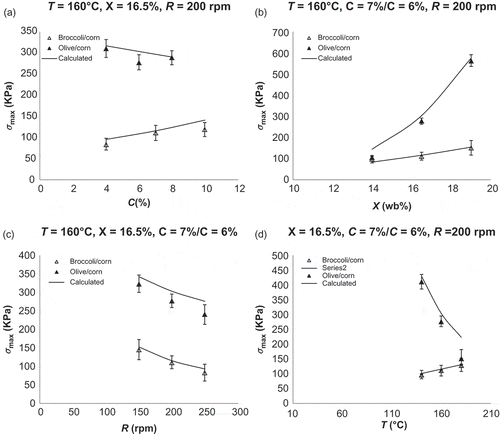
Maximum stress, maximum strain, elasticity parameter, and number of cracks during compression have been correlated with feed moisture content, extrusion temperature, screw speed, and broccoli or olive paste concentration. The regression analysis of the applied mathematical models for the two materials is presented in . The applied mathematical models fit well to the experimental data. present the maximum stress of corn extrudates containing broccoli and olive paste. Maximum stress and strain are indicative of the breakage point during the compression test, while the elasticity parameter is related to the hardness of the extruded snacks. In addition, the number of cracks during compression is a measure of crispness of the material. The compression parameters are controlled by the density and the thickness of the external walls and the swelling.[Citation43,Citation44] Maximum stress presented an increment for broccoli/corn samples, while broccoli concentration, extrusion temperature, and feed moisture content were increasing. Samples with olive paste exhibit an opposite behavior concerning olive paste concentration and extrusion temperature. Screw speed causes a decrement of maximum stress for both materials. Maximum strain of broccoli/corn extruded snacks increased as extruding temperature increases and decreased with the increment of broccoli concentration, screw speed and feed moisture content. Samples containing olive paste present the same behavior concerning temperature and screw speed and an opposite behavior concerning olive paste concentration and feed moisture content (). Maximum stress usually exhibits the same behavior with elasticity parameter,[Citation43] as it is obvious at the results except from the alterations in olive/corn samples with different olive concentrations and screw speed values (). The number of cracks during compression for both materials is presented in . Crispness is related with a rapid drop of force during the mastication process. Thus, number of cracks during compression analysis, which are a measure of the rapid drop of force during the test, is a measure of crispness.[Citation45] The increment of broccoli concentration and extrusion temperature causes a decrement in number of cracks. However, the increment of screw speed and feed moisture content causes an increment in number of cracks of broccoli/corn samples. Number of cracks of olive/corn samples presented in all cases a decrement, except an increment, which was caused from the increment of extrusion temperature.
Figure 5 Maximum strain for broccoli/corn and olive/corn snacks correlated with: (a) broccoli or olive paste/corn ratio, C (%), (b) feed moisture, X (wb%), (c) screw speed (rpm), and (d) extrusion temperature, T (°C).
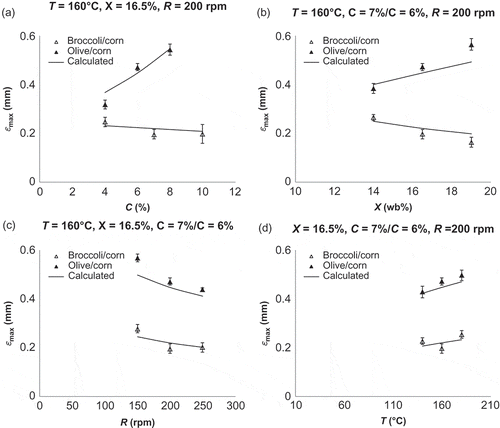
Figure 6 Elasticity parameter for broccoli/corn and olive/corn snacks correlated with: (a) broccoli or olive paste/corn ratio, C (%), (b) feed moisture, X (wb%), (c) screw speed (rpm), and (d) extrusion temperature, T (°C).
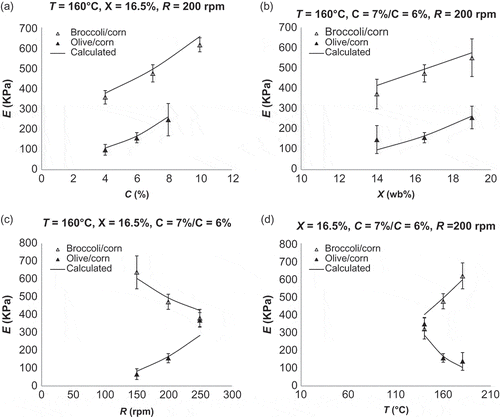
Figure 7 Number of cracks during compression tests for broccoli/corn and olive/corn snacks correlated with: (a) broccoli or olive paste/corn ratio, C (%), (b) feed moisture, X (wb%), (c) screw speed (rpm), and (d) extrusion temperature, T (°C).
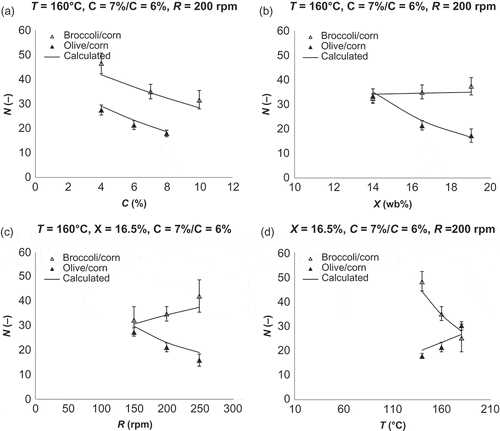
The increment in cell wall thickness of extruded snacks as extruder temperature increasing causes an increment in breakage point and elasticity parameter and a decrement in crispness and thus in the number of cracks during compression[Citation43,Citation44] as it presented in samples enriched with broccoli as extruder temperature was increasing. Moreover, amylopectin plasticization and amylose deterioration that are commonly done by extrusion at 120–220°C affect the density of extruded snacks.[Citation46] The same behavior was observed for samples enriched with broccoli as broccoli concentration, and feed moisture content were increased. Concerning the feed moisture content, this behavior could be due to water, which acts as a plasticizer of the starch material inside the extruder, increasing raw material moisture content under low extrusion temperature conditions, reducing the viscosity of this mass. Thus, starch gelatinization is reduced and bubble growth is suppressed, resulting in a denser, harder, and less crunchy final product.[Citation47] Broccoli and olive paste consist, among others, of dietary fibers. Extruded products containing fibers, such as broccoli or olive paste, in high concentrations are usually compact, tough, not crisp, and with undesirable texture due to the low expansion ratio. Fiber particles cause its decrement by rupturing the cell walls before the gas bubbles could expand to their full potential.[Citation8,Citation48] Moreover, the presence of lipids significantly affects and leads to a reduction of expansion ratio, which affects the total hardness of the samples.[Citation49] Thus, extruded snacks that contain lipids are more difficult to expand due to mixture slippage within the extruder barrel[Citation48,Citation50] and consequently their hardness presented an increment as olive paste content increased. Expansion ratio, which affects the snacks’ hardness, is decreased with the increment of screw speed during extrusion[Citation44,Citation51] and could be correlated with the decrement in breaking point and elasticity parameter and an increment in number of cracks since the samples became less hard and more crispy. The differences between the behavior of samples enriched with broccoli and olive paste concerning the increment in extrusion temperature could be due to the reduction of the viscosity of the materials containing olive paste within the extruder, thus favoring bubble growth in the molten material, consequently increasing extrudates’ expansion and reducing hardness.[Citation47]
CONCLUSION
Thermal, textural, and physicochemical analysis of extruded snacks based on corn flour enriched with broccoli or olive paste has been performed. Process conditions during the extrusion as well as the raw materials’ characteristics have been proved to affect the measured properties. Simple mathematical models were developed and correlated well the process conditions and the raw materials’ characteristics with the measured properties. In specific, extruded corn snacks enriched with broccoli become harder with the increase of broccoli concentration, extrusion temperature, and feed moisture content, while the increase in screw speed derived in softer snacks. In addition, the increase of feed moisture content and screw speed causes an increment in snacks’ crispness. Extruded corn snacks enriched with olive paste became less hard and crispier as the extrusion temperature increased and harder and less crispy with the increment of olive paste concentration, screw speed, and feed moisture content. Both broccoli/corn and olive/corn samples present an increment of water sorption in higher feed moisture content and lower extrusion temperature while slight differences were presented in the different content concentrations and screw speed values. To conclude within the limitation of this article and concerning the examined properties, the most appropriate product conditions and material characteristics, which produce more soft and crispy extrudates, are extruded snacks based on corn flour enriched with broccoli (broccoli concentration: 4%, extrusion temperature: 160°C, screw speed: 200, feed moisture content: 16.5%) and extruded snacks based on corn flour enriched with olive paste (olive paste concentration: 4%, extrusion temperature: 160°C, screw speed: 150, feed moisture content: 14%).
FUNDING
This work has been performed under the framework of Basic Research Project 2010, funded by the National Technical University of Athens.
REFERENCES
- Dehghan-Shoar, Z.; Hardacre, A.K.; Brennan, C.S. The physico-chemical characteristics of extruded snacks enriched with tomato lycopene. Food Chemistry 2010, 123 (4), 1117–1122.
- Anton, A.A.; Gary Fulcher, R.; Arntfield, S.D. Physical and nutritional impact of fortification of corn starch-based extruded snacks with common bean (Phaseolus vulgaris L.) flour: Effects of bean addition and extrusion cooking. Food Chemistry 2009, 113 (4), 989–996.
- Jansen, G.R.; Harper, J.M.; O’Deen, L. Nutritional evaluation of blended foods made with low-cost extruder cooker. Journal of Food Science 1978, 43 (3), 912–915.
- Konstance, R.P.; Onwulata, C.I.; Smith, P.W.; Lu, D.; Tunick, M.H.; Strange, E.D.; Holsinger, V.H. Nutrient-based corn and soy products by twin-screw extrusion. Journal of Food Science 1998, 63 (5), 864–868.
- Shaviklo, G.R.; Thorkelsson, G.; Rafipour, F.; Sigurgisladottir, S. Quality and storage stability of extruded puffed corn-fish snacks during 6-month storage at ambient temperature. Journal of the Science of Food and Agriculture 2011, 91 (5), 886–893.
- Rampersad, R.; Badrie, N.; Comissiong, E. Physico-chemical and sensory characteristics of flavored snacks from extruded cassava/pigeonpea flour. Journal of Food Science 2003, 68 (1), 363–367.
- Dogan, H.; Gueven, A.; Hicsasmaz, Z. Extrusion cooking of lentil flour (lens culinaris–red)–corn starch–corn oil mixtures. International Journal of Food Properties 2011, 16 (2), 341–358.
- Liu, Y.; Hsieh, F.; Heymann, H.; Huff, H.E. Effect of process conditions on the physical and sensory properties of extruded oat-corn puff. Journal of Food Science 2000, 65 (7), 1253–1259.
- Onwulata, C.I.; Konstance, R.P.; Smith, P.W.; Holsinger, V.H. Co-extrusion of dietary fiber and milk proteins in expanded corn products. LWT–Food Science and Technology 2001, 34 (7), 424–429.
- Jose De, J.B. Extrusion cooking of legumes: Dry bean flours. In: Encyclopedia of Agricultural, Food, and Biological Engineering; Taylor & Francis: New York, 2007; 1–8.
- Zhang, D.; Hamauzu, Y. Phenolics, ascorbic acid, carotenoids and antioxidant activity of broccoli and their changes during conventional and microwave cooking. Food Chemistry 2004, 88 (4), 503–509.
- Nipat, L.; Makiko, T.; Itaru, S.; Kazuko, N.; Chulaluck, C.; Seiichiro, I. Functional properties of cereal and legume based extruded snack foods fortified with by-products from herbs and vegetables. Kasetsart Journal: Natural Science 2010, 44 (2), 271–279.
- Upadhyay, A.; Sharma, H.K.; Sarkar, B.C. Optimization of carrot pomace powder incorporation on extruded product quality by response surface methodology. Journal of Food Quality 2010, 33 (3), 350–369.
- Őzer, E.A.; Herken, E.N.; Güzel, S.; Ainsworth, P.; İbanoğlu, Ş. Effect of extrusion process on the antioxidant activity and total phenolics in a nutritious snack food. International Journal of Food Science & Technology 2006, 41 (3), 289–293.
- Liu, S.; Alavi, S.; Abughoush, M. Extruded moringa leaf–oat flour snacks: Physical, nutritional, and sensory properties. International Journal of Food Properties 2011, 14 (4), 854–869.
- Devi, N.L.; Shobha, S.; Tang, X.; Shaur, S.A.; Dogan, H.; Alavi, S. Development of protein-rich sorghum-based expanded snacks using extrusion technology. International Journal of Food Properties 2011, 16 (2), 263–276.
- Price, K.R.; Casuscelli, F.; Colquhoun, I.J.; Rhodes, M.J.C. Composition and content of flavonol glycosides in broccoli florets (Brassica olearacea) and their fate during cooking. Journal of the Science of Food and Agriculture 1998, 77 (4), 468–472.
- Price, K.R.; Casuscelli, F.; Colquhoun, I.J.; Rhodes, M.J.C. Hydroxycinnamic acid esters from broccoli florets. Phytochemistry 1997, 45 (8), 1683–1687.
- Allouche, Y.; Jiménez, A.; Uceda, M.; Paz Aguilera, M.; Gaforio, J.J.; Beltrán, G. Influence of olive paste preparation conditions on virgin olive oil triterpenic compounds at laboratory-scale. Food Chemistry 2010, 119 (2), 765–769.
- Juan, E.M.; Planas, M.J.; Ruiz-Gutierrez, V.; Daniel, H.; Wenzel, U. Antiproliferative and apoptosis-inducing effects of maslinic and oleanolic acids, two pentacyclic triterpenes from olives, on HT-29 colon cancer cells. British Journal of Nutrition 2008, 100 (1), 36–43.
- Altan, A.; McCarthy, K.L.; Maskan, M. Evaluation of snack foods from barley–tomato pomace blends by extrusion processing. Journal of Food Engineering 2008, 84 (2), 231–242.
- Camire, M.E.; Dougherty, M.P.; Briggs, J.L. Functionality of fruit powders in extruded corn breakfast cereals. Food Chemistry 2007, 101 (2), 765–770.
- Krokida, M.K.; Marinos-Kouris, D. Rehydration kinetics of dehydrated products. Journal of Food Engineering 2003, 57 (1), 1–7.
- Krokida, M.K.; Karathanos, V.T.; Maroulis, Z.B. Effect of freeze-drying conditions on shrinkage and porosity of dehydrated agricultural products. Journal of Food Engineering 1998, 35 (4), 369–380.
- Oikonomopoulou, V.P.; Krokida, M.K.; Karathanos, V.T. Structural properties of freeze-dried rice. Journal of Food Engineering 2011, 107 (3–4), 326–333.
- Mazumder, P.; Roopa, B.S.; Bhattacharya, S. Textural attributes of a model snack food at different moisture contents. Journal of Food Engineering 2007, 79 (2), 511–516.
- Vincent, J.F.V. The quantification of crispness. Journal of the Science of Food and Agriculture 1998, 78 (2), 162–168.
- Gogoi, B.K.; Alavi, S.H.; Rizvi, S.S.H. Mechanical properties of protein-stabilized starch-based supercritical fluid extrudates. International Journal of Food Properties 2000, 3 (1), 37–58.
- Sablani, S.S.; Kasapis, S.; Rahman, M.S. Evaluating water activity and glass transition concepts for food stability. Journal of Food Engineering 2007, 78 (1), 266–271.
- AOAC. Official Methods of Analysis, Association of Official Analytical Chemists, 14th Ed.; AOAC: Washington, DC, 1990.
- Bengoechea, C.; Arrachid, A.; Guerrero, A.; Hill, S.E.; Mitchell, J.R. Relationship between the glass transition temperature and the melt flow behavior for gluten, casein and soya. Journal of Cereal Science 2007, 45 (3), 275–284.
- Shankar, T.; Sokhansanj, S.; Bandyopadhyay, S.; Bawa, A. Storage properties of low fat fish and rice flour coextrudates. Food and Bioprocess Technology 2010, 3 (4), 481–490.
- Maroulis, Z.B.; Tsami, E.; Marinos-Kouris, D.; Saravacos, G.D. Application of the GAB model to the moisture sorption isotherms for dried fruits. Journal of Food Engineering 1988, 7 (1), 63–78.
- Enrione, J.I.; Hill, S.E.; Mitchell, J.R. Sorption behavior of mixtures of glycerol and starch. Journal of Agricultural and Food Chemistry 2007, 55 (8), 2956–2963.
- Pelissari, F.M.; Yamashita, F.; Grossmann, M.V.E. Extrusion parameters related to starch/chitosan active films properties. International Journal of Food Science & Technology 2011, 46 (4), 702–710.
- Ubwa, S.T.; Abah, J.K.; Shambe, A.T. Studies on the gelatinization temperature of some cereal starches. International Journal of Chemistry 2012, 4 (6), 22–28.
- Sreekala, M.S.; Kumaran, M.G.; Thomas, S. Water sorption in oil palm fiber reinforced phenol formaldehyde composites. Composites Part A: Applied Science and Manufacturing 2002, 33 (6), 763–777.
- El Riachy, M.; Priego-Capote, F.; León, L.; Rallo, L.; Luque de Castro, M.D. Hydrophilic antioxidants of virgin olive oil. Part 1: Hydrophilic phenols: A key factor for virgin olive oil quality. European Journal of Lipid Science and Technology 2011, 113 (6), 678–691.
- Perdomo, J.; Cova, A.; Sandoval, A.J.; García, L.; Laredo, E.; Müller, A.J. Glass transition temperatures and water sorption isotherms of cassava starch. Carbohydrate Polymers 2009, 76 (2), 305–313.
- Hsieh, F.; Huff, H.E. Extrusion cooking of corn meal with soy fiber, salt, and sugar. Cereal Chemistry 1994, 71 (3), 227–234
- Lazou, A.; Krokida, M. Thermal characterisation of corn–lentil extruded snacks. Food Chemistry 2011, 127 (4), 1625–1633.
- Kaletunc, G.; Breslauer, K.J. Glass transitions of extrudates: Relationship with processing-induced fragmentation and end-product attributes. Cereal Chemistry 1993, 70 (5), 548–552.
- Hutchinson, R.J.; Siodlak, G.D.E.; Smith, A.C. Influence of processing variables on the mechanical properties of extruded maize. Journal of Materials Science 1987, 22 (11), 3956–3962.
- Agbisit, R.; Alavi, S.; Cheng, E.; Herald, T.; Trater, A. Relationships between microstructure and mechanical properties of cellular cornstarch extrudates. Journal of Texture Studies 2007, 38 (2), 199–219.
- Anton, A.A.; Luciano, F.B. Instrumental texture evaluation of extruded snack foods: A review. Ciencia y Tecnología Alimentaria 2007, 5 (4), 245–251.
- Müller, R.-J.; Kleeberg, I.; Deckwer, W.-D. Biodegradation of polyesters containing aromatic constituents. Journal of Biotechnology 2001, 86 (2), 87–95.
- Ferreira, R.E.; Chang, Y.K.; Steel, C.J. influence of wheat bran addition and of thermoplastic extrusion process parameters on physical properties of corn-based expanded extruded snacks. Alimentos e Nutrição Araraquara 2011, 22 (4), 507–520.
- Steel, C.J.; Leoro, M.G.V.; Schmiele, M.; Ferreira, R.E.; Chang, Y.K. Thermoplastic extrusion in food processing. In: Thermoplastic Elastomers; El-Sonbati, A.Z.; Ed; InTech: Rijeka, Croatia, 2012; 265--290.
- Colonna, P.; Tayeb, J.; Mercier, C. Extrusion cooking of starch and starchy products. In: Extrusion Cooking; American Association of Cereal Chemists: Saint Paul, MN, 1998; 247–319.
- Mian, R. Extruded snacks. In: Handbook of Food Science, Technology, and Engineering, Vol. Four; CRC Press: Boca Raton, Florida, 2005; 168-1–168-8.
- Allen, K.E.; Carpenter, C.E.; Walsh, M.K. Influence of protein level and starch type on an extrusion-expanded whey product. International Journal of Food Science & Technology 2007, 42 (8), 953–960.

